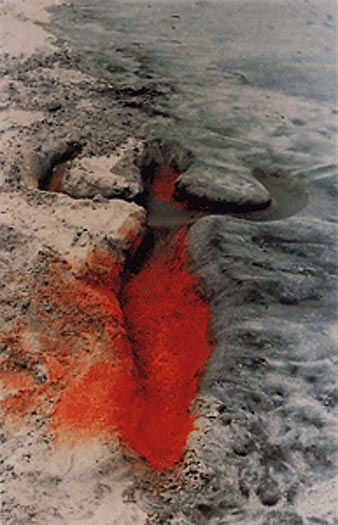Ana Mendieta, Earth Artist
- ResidentAlien
- May 27, 2016
- 3 min read

I stumbled upon Ana a few years back. It was by sheer luck, or perhaps fate, that our paths had crossed via the Internet. It was during my undergrad years when I thought I would just get my Bachelor of Art degree and open a small photo studio where I would most likely be taking glam shots of middle-aged women and budding teens. Needless to say, I did not delve very deep into the process behind her practice. I was merely a simple admirer from one crazy feminist, earth-loving individual to another.
Now that I have been working towards my MFA in Visual Art, at least once a semester, I have been hearing her name whispered in my ear. “Ana.” they say, “You will love her! Your work reminds me of hers!” So this semester I have tried to dig in and grasp a greater understanding of how our art practices parallel, contrast and if, with a little more insight, how her work can help in expanding my own.
What is most relevant to me is the idea that Ana worked with the earth so that she could feel connected to a land in which she felt alienated. She was torn from her homeland of Cuba as a young girl and grew up in foster care in Iowa. This is in direct correlation with my own feelings from adolescence, which I am still dealing with and now carry over into my art practice as an adult. Because of my own experiences as a young child who was also torn from her homeland, I am able to sympathize with Ana. In solidarity, we have both been disconnected from our places of birth and ancestral lands. The work she produced in nature using the earth itself could have possibly been looked at as a way for her to heal. My intuitive nature tells me that the earth can work as a conduit that absorbs ones trauma helping to assist in the healing process.
This process of pressing one’s self into the earth is a technique I have flirted with throughout my life. As a person whom has felt alienated from my current place of residence, as well as feeling disconnected from her native sands, it is pertinent to me that I am able to feel connected to my birthplace even if it is in an abstract and nonconventional manner. Such as creating imprints with my body or even just meditating encompassed in nature, whether it is forest bathing or emerging myself in natural bodies of water, these are all methods that I use to heal myself. What I find extremely interesting is the possibility that the ritual of embedding oneself into the earth can work both ways. Whereas, even though you are integrating yourself with nature and allowing the ground to extract your impurities from your body, you in turn, extract some of the landscapes trauma that it has laid witness to throughout history.

In an essay written by Charles Merewhether, Ana was quoted as saying:
“ My exploration through my art of the relationship between myself and nature has been a clear result of my having been torn from my homeland during my adolescence. The making of my silueta in nature keeps the transition between my homeland and my new home. It is a way of reclaiming my roots and becoming one with nature. Although the culture in which I live is part of me, my roots and cultural identity are a result of my Cuban heritage.”
This is a vital position, which I adhere to in my own work. The integration with nature coupled with the desire to keep alive what little amounts of cultural knowledge one may have absorbed in youth, or even perhaps, grasping for those flashes of ancestral memories: these are best tapped into via artistic practices. I understand the necessity of healing through natural resources including herbal tinctures, consumption of fresh foods, and the ability to heal ones spirit by soaking up the life forces contained within the dirt, rocks, trees and waters. Our great Mother Earth is the only entity that is able to console me and revive my energies via her all encompassing womb. After all, She is the only piece of tangible property that physically connects both Ana and myself to our homelands.
Bibliography
Davis, Ben. "Ana Mendieta's Niece Gets Candid About the Artist's Film Works." Artnet News. N.p., 24 Mar. 2016. Web. 2 May 2016. <https://news.artnet.com/people/ana-mendieta-film-work-niece-video-458435>.
Merewether, Ed. "From Inscription to Dissolution." Corpus Delecti: Performance Art of the Americas. Ed. Coco Fusco. London: Routledge, 2000. N. pag. 134-147 Print.
Quinton, Jared. "Coco Fusco on the Enduring Legacy of Groundbreaking Cuban Artist Ana Mendieta." Artsy. N.p., 3 Feb. 2016. Web. 2 May 2016. <https://www.artsy.net/article/artsy-editorial-ana-mendieta-s-enduring-legacy-in-the-words-of-coco-fusco>.
"The Deathly Silhuetas of Ana Mendieta." Spotted Couch. N.p., 21 Feb. 2014. Web. 28 Apr. 2016. <https://spottedcouchartcrimeblog.com/2014/02/21/the-deathly-siluetas-of-ana-mendieta/>.



























Comments